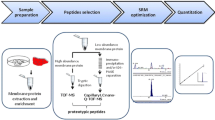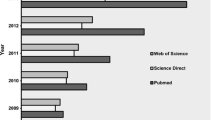ABSTRACT
Purpose
The expression levels of several efflux drug transporters in the liver and kidney were evaluated across species to address potential roles of the transporters in species dependent excretion of drugs and their metabolites.
Methods
Four efflux transporters, namely MDR1/P-gp, BCRP/Bcrp, MRP2/Mrp2 and MRP3/Mrp3 in liver and kidney in three preclinical species and humans were quantified using targeted quantitative proteomics by isotope dilution nanoLC-MS/MS.
Results
In liver, the level of P-gp was highest in monkey and lowest in rat. The concentration of BCRP/Bcrp was highest in dog followed by monkey. MRP2/Mrp2 level was highest in monkey and rat, whereas MRP3/Mrp3 levels were similar in human, monkey and dog. In the kidney, the concentrations of MDR1/P-gp in human and monkey were roughly 2 to 3-fold higher than in rat and dog. In rat, BCRP/Bcrp concentrations were substantially higher than in any of the other species. MRP2/Mrp2 concentrations were similar across species, whereas expression of MRP3/Mrp3 was highest in rat.
Conclusion
Overall, the results indicated that the pattern of hepatic and renal expression of the transporters was quite species dependent. This information should be helpful in the estimation of transport mediated drug and metabolites excretion in liver and kidney across species.

Similar content being viewed by others
Abbreviations
- BCRP/Bcrp:
-
Breast cancer resistant protein
- LC:
-
Liquid chromatography
- MDR1:
-
Multidrug resistance protein 1
- MRM:
-
Multiple reaction monitoring
- MRP/Mrp:
-
Multidrug resistance-associated protein
- MS:
-
Mass spectrometry
- P-gp:
-
P-glycoprotein 1
- SIL:
-
Stable isotope label(ed)
REFERENCES
Smith RL. The excretory function of bile: the elimination of drugs and toxic substances in bile. London: Chapman and Hall; 1973.
Ito K, Iwatsubo T, Kanamitsu S, Nakajima Y, Sugiyama Y. Quantitative prediction of in vivo drug clearance and drug interactions from in vitro data on metabolism, together with binding and transport. Annu Rev Pharmacol Toxicol. 1998;38:461–99.
Maher JM, Cheng X, Slitt AL, Dieter MZ, Klaassen CD. Induction of the multidrug resistance-associated protein family of transporters by chemical activators of receptor-mediated pathways in mouse liver. Drug Metab Dispos. 2005;33(7):956–62.
Maher JM, Cherrington NJ, Slitt AL, Klaassen CD. Tissue distribution and induction of the rat multidrug resistance-associated proteins 5 and 6. Life Sci. 2006;78(19):2219–25.
Cheng X, Klaassen CD. Regulation of mRNA expression of xenobiotic transporters by the pregnane X receptor in mouse liver, kidney, and intestine. Drug Metab Dispos. 2006;34(11):1863–7.
Ohtsuki S, Schaefer O, Kawakami H, Inoue T, Liehner S, Saito A, et al. Simultaneous absolute protein quantification of transporters, cytochromes P450, and UDP-glucuronosyltransferases as a novel approach for the characterization of individual human liver: comparison with mRNA levels and activities. Drug Metab Dispos. 2012;40(1):83–92.
Chu X, Bleasby K, Evers R. Species differences in drug transporters and implications for translating preclinical findings to humans. Expert Opin Drug Metab Toxicol. 2013;9(3):237–52.
Wang L, Prasad B, Salphati L, Chu X, Gupta A, Hop CE, et al. Interspecies variability in expression of hepatobiliary transporters across human, dog, monkey, and rat as determined by quantitative proteomics. Drug Metab Dispos. 2015;43(3):367–74.
Uchida Y, Toyohara T, Ohtsuki S, Moriyama Y, Abe T, Terasaki T. Quantitative targeted absolute proteomics for 28 transporters in brush-border and basolateral membrane fractions of rat kidney. J Pharm Sci. 2015;105(2):1011–6.
Schinkel AH, Jonker JW. Mammalian drug efflux transporters of the ATP binding cassette (ABC) family: an overview. Adv Drug Rev. 2003;55(1):3–29.
van Herwaarden AE, Schinkel AH. The function of breast cancer resistance protein in epithelial barriers, stem cells and milk secretion of drugs and xenotoxins. Trends Pharmacol Sci. 2006;27(1):10–6.
Borst P, Schinkel AH. P-glycoprotein ABCB1: a major player in drug handling by mammals. J Clin Invest. 2013;123(10):4131–3.
Szakacs G, Varadi A, Ozvegy-Laczka C, Sarkadi B. The role of ABC transporters in drug absorption, distribution, metabolism, excretion and toxicity (ADMETox). Drug Discov Today. 2008;13(9–10):379–93.
Giacomini KM, Huang S-M, Tweedie DJ, Benet LZ, Brouwer KLR, Chu X, et al. Membrane transporters in drug. development. Nat Rev Drug Discov. 2010;9(3):215–36.
Konig J, Nies AT, Cui Y, Leier I, Keppler D. Conjugate export pumps of the multidrug resistance protein (MRP) family: localization, substrate specificity, and MRP2-mediated drug resistance. Biochim Biophys Acta. 1999;1461(2):377–94.
Kruh GD, Belinsky MG. The MRP family of drug transporters. Oncogene. 2003;22(47):7537–52.
Chan LM, Lowes S, Hirst BH. The ABCs of drug transport in intestine and liver: efflux proteins limiting drug absorption and bioavailability. Eur J Pharm Sci. 2004;21(1):25–51.
Büchler M, König J, Brom M, Kartenbeck J, Spring H, Horie T, et al. cDNA cloning of the hepatocyte canalicular isoform of the multidrug resistance protein, cMRP, reveals a novel conjugate export pump deficient in hyperbilirubinemic mutant rats. J Biol Chem. 1996;271(25):15091–8.
Hirohashi T, Ito K, Ogawa K, Suzuki H, Kume K, Shimizu T, et al. Hepatic expression of multidrug resistance-associated protein (MRP)-like proteins maintained in Eisai hyperbilirubinemic rats. Mol Pharmacol. 1998;53(6):1068–75.
Ogawa K, Suzuki H, Hirohashi T, Ishikawa T, Meier PJ, Hirose K, et al. Characterization of inducible nature of MRP3 in rat liver. Am J Physiol Gastrointest Liver Physiol. 2000;278(3):G438–46.
Kim M-S, Liu DQ, Strauss J, Capodanno I, Yao Z, Fenyk-Melody J, et al. Metabolism and disposition of gemfibrozil in wistar and multidrug resistance-associated protein 2-deficient TR−rats. Xenobiotica. 2003;33(10):1027–42.
Renes J, de Vries EGE, Jansen PLM, Müller M. The (patho) physiological functions of the MRP family. Drug Resist Updat. 2000;3(5):289–302.
Fallon JK, Neubert H, Hyland R, Goosen TC, Smith PC. Targeted quantitative proteomics for the analysis of 14 UGT1As and -2Bs in human liver using nanoUPLC-MS/MS with selected reaction monitoring. J Proteome Res. 2013;12(10):4402–13.
Fallon JK, Neubert H, Goosen TC, Smith PC. Targeted precise quantification of 12 human recombinant uridine-diphosphate glucuronosyl transferase 1A and 2B isoforms using nano-ultra-high-performance liquid chromatography/tandem mass spectrometry with selected reaction monitoring. Drug Metab Dispos. 2013;41(12):2076–80.
Smith PC, Fallon JK, Kubik N, Booth-Genthe CL. Measurement of membrane transporter proteins in human lung using quantitative targeted absolute proteomics (QTAP). US HUPO 9th Annual Conference, 2013;March 10–13:Poster 097.
Higgins JW, Bao JQ, Ke AB, Manro JR, Fallon JK, Smith PC, et al. Utility of oatp1a/1b-knockout and OATP1B1/3-humanized mice in the study of OATP-mediated pharmacokinetics and tissue distribution: case studies with pravastatin, atorvastatin, simvastatin, and carboxydichlorofluorescein. Drug Metab Dispos. 2014;42(1):182–92.
Knights KM, Spencer SM, Fallon JK, Chau N, Smith PC, Miners JO. Scaling factors for the in vitro-in vivo extrapolation (IV-IVE) of renal drug and xenobiotic glucuronidation clearance. Br J Clin Pharmacol. 2016;81(6):1153–64.
Asher GN, Fallon JK, Smith PC. UGT concentrations in human rectal tissue after multidose, oral curcumin. Pharmacol Res Perspect. 2016;4(2), e00222.
Kochansky CJ, Xia YQ, Wang S, Cato B, Creighton M, Vincent SH, et al. Species differences in the elimination of a peroxisome proliferator-activated receptor agonist highlighted by oxidative metabolism of its acyl glucuronide. Drug Metab Dispos. 2005;33(12):1894–904.
Sallustio BC, Sabordo L, Evans AM, Nation RL. Hepatic disposition of electrophilic acyl glucuronide conjugates. Curr Drug Metab. 2000;1(2):163–80.
Nezasa K, Tian X, Zamek-Gliszczynsli MJ, Patel NJ, Raub TJ, Brower KL. Altered hepatobiliary disposition of 5 (and 6)-carboxy-2′,7′-dichlorofluorescein in Abcg2 (Bcrp1) and Abcc2 (Mrp 2) knockout mice. Drug Metab Dipos. 2006;34(4):718–23.
Ishizuka H, Konno K, Shiina T, Naganuma H, Nishimura K, Ito K, et al. Species differences in the transport activity for organic anions across the bile canalicular membrane. Pharmacol Exp Ther. 1999;290(3):1324–30.
Ninomiya M, Ito K, Horie T. Functional analysis of dog multidrug resistance-associated protein 2 (Mrp2) in comparison with rat Mrp2. Drug Metab Dispos. 2005;33(2):225–32.
Zimmermann C, van de Wetering K, van de Steeg E, Wagenaar E, Vens C, Schinkel AH. Species-dependent tansport and modulation properties of human and mouse multidrug resistance protein 2 (MRP2/Mrp2, ABCC2/Abcc2). Drug Metab Dispos. 2008;36(4):631–40.
Leazer TM, Klaassen CD. The presence of xenobiotic transporters in rat placenta. Drug Metab Dispos. 2003;31(2):153–67.
Prasad B, Evers R, Gupta A, Hop CE, Salphati L, Shukla S, et al. Interindividual variability in hepatic organic anion-transporting polypeptides and P-glycoprotein (ABCB1) protein expression: quantification by liquid chromatography tandem mass spectroscopy and influence of genotype, age, and sex. Drug Metab Dispos. 2014;42(1):78–88.
Koenig E, Gray J, Xia CQ, Yang H, Kim M-S. Evaluation of species differences in the expression of drug transporters. 11th European Regional ISSX Meeting 2009 (Lisbon, Portugal, 17–20 May). ISSX Online Abstracts, Supplement 4, No. 2, 2009 (http://issx.confex.com/issx/11euro/webprogram/Paper14736.html).
Li N, Zhang Y, Hua F, Lai Y. Absolute difference of hapatobiliary transpoeter multidrug resistance-associated protein (MRP2/Mrp2) in liver tissues and isolated hepatocytes from rat, dog, monkey and human. Drug Metab Dispos. 2009;37(1):66–73.
Peng K-W, Bacon Zheng M, Guo Y, Wang MZ. Ethnic variability in the expression of hepatic drug transporters: absolute quantification by an optimized targeted quantitative proteomic approach. Drug Metab Dispos. 2015;43(7):1045–55.
Morrissey KM, Stocker SL, Wittwer MB, Xu L, Giacomini KM. Renal transporters in drug development. Annu Rev Pharmacol Toxicol. 2013;53:503–29.
ACKNOWLEDGMENTS AND DISCLOSURES
We thank Aimy Tse and Bingli Ma for providing tissue samples for the study. The study was funded by Takeda Pharmaceuticals International Co. and supported in part by an NIH instrumentation grant, S10, RR024595.
Author information
Authors and Affiliations
Corresponding author
Rights and permissions
About this article
Cite this article
Fallon, J.K., Smith, P.C., Xia, C.Q. et al. Quantification of Four Efflux Drug Transporters in Liver and Kidney Across Species Using Targeted Quantitative Proteomics by Isotope Dilution NanoLC-MS/MS. Pharm Res 33, 2280–2288 (2016). https://doi.org/10.1007/s11095-016-1966-5
Received:
Accepted:
Published:
Issue Date:
DOI: https://doi.org/10.1007/s11095-016-1966-5




